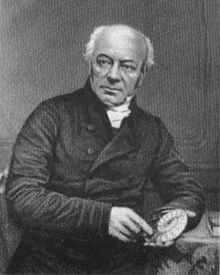Cycadeoidea
| Cycadeoidea Temporal range:
| |
|---|---|

| |
| C. marylandica specimen on display at the National Museum of Natural History | |
| Scientific classification | |
| Kingdom: | |
| (unranked): | |
| Division: | |
| Order: | |
| Family: | |
| Genus: | Cycadeoidea Buckland, 1828
|
| Species | |
Cycadeoidea is an extinct genus of bennettitalean plant that is known from fossil finds in North America and Europe and lived during the Jurassic and Cretaceous periods.[3]
Taxonomy

William Buckland originally gave the name to two species he described, C. megalophylla and C. microphylla, in 1828, seeing characteristics akin to living cycads.[4] Robert Brown and Mr. Loddiges of Loddiges Nursery in Hackney had seen living cycads and urged him to name the fossils after them.[2] The original type specimens of both taxa have not been located, so new type material has been chosen.[2]
Classification of species within the genus is very difficult, as several trunks have been described as species, and a further fourteen species are known from detached leaf remains, but there is no way of telling which leaf remains go with which trunk remains (if any).[2]
Description
Cycadeoidea stems were "short and barrel-shaped," with a "crown of pinnate leaves" atop the stem.[3] The majority of Cycadeoidea species were bisexual. The genus may have undergone self-pollination, although it is also possible that insects were involved in the process.[3] The size and shape of the trunk has been used to distinguish species, however forms intermediate between two species suggest the two might be merely different-sized or aged plants can't be excluded.[2]
Fossil sites and species
The Isle of Portland was the site of the first specimens recovered, described by Buckland as C. megalophylla (the type species) and C. microphylla.[2]
Cycadeoidea gibsoniana is a species collected from Lower Greensand from Luccombe Chine on the Isle of Wight, notable for the remarkable state of preservation of its plant parts. The original specimen was found by Thomas Field Gibson and was extensively broken and sliced to examine its anatomy.[2][5]
Four well preserved cones of a species C. maccafferyi were uncovered in the Upper Cretaceous Haslam Formation on Vancouver and Hornby Island in British Columbia.[1]
References
- ^ a b Rothwell, G. W.; Stockey, R. A. (2002). "Anatomically preserved Cycadeoidea (Cycadeoidaceae), with a reevaluation of systematic characters for the seed cones of Bennettitales". American Journal of Botany. 89 (9): 1447–1458. doi:10.3732/ajb.89.9.1447. PMID 21665746. Retrieved 14 January 2012.
- ^ a b c d e f g h Watson, Joan; Lydon, Susannah J (2004). "The bennettitalean trunk genera Cycadeoidea and Monanthesia in the Purbeck, Wealden and Lower Greensand of southern England: A reassessment". Cretaceous Research. 25: 1. doi:10.1016/j.cretres.2003.10.003.
- ^ a b c Palmer, Douglas; et al. (2009). Prehistoric life : the definitive visual history of life on earth (1st American ed.). New York: Dorling Kindersley. p. 288. ISBN 978-0-7566-5573-0.
- ^ Buckland, William (1836). Geology and mineralogy considered with reference to natural theology. Vol. 1. London: William Pickering. p. 496. Retrieved 18 January 2012.
- ^ "Thomas Gibson & Thomas Field Gibson". Dictionary of Unitarian and Universalist Biography. Retrieved 20 November 2017.
{{cite web}}: Cite has empty unknown parameter:|dead-url=(help)
- Bennettitales
- Jurassic plants
- Cretaceous plants
- Prehistoric plant genera
- Jurassic life of Europe
- Jurassic life of North America
- Cretaceous life of Europe
- Cretaceous life of North America
- Jurassic first appearances
- Cretaceous extinctions
- Taxa named by William Buckland
- Fossil taxa described in 1828
- Prehistoric plants of North America
